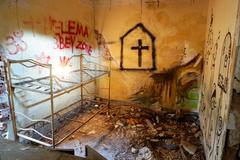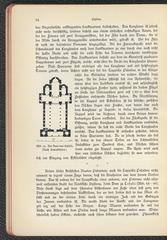Castello di Cefalù: Visiting Hours, Tickets, and Historical Site Guide
Date: 14/06/2025
Introduction to Castello di Cefalù and Its Significance
Perched atop the dramatic 270-meter-high La Rocca promontory overlooking the medieval town of Cefalù on Sicily’s northern coast, the Castello di Cefalù stands as a monument to the island’s rich and layered history. Over millennia, this strategic site has witnessed the rise and fall of Greek, Roman, Byzantine, Arab, Norman, and Swabian civilizations, each leaving an indelible mark on its architecture and cultural landscape. Today, visitors can explore not only the evocative castle ruins but also the remarkable Temple of Diana—a rare megalithic sanctuary predating classical antiquity.
The castle’s commanding views over the Tyrrhenian Sea and its imposing natural defenses made it a critical military and economic hub through various historical periods. As part of the broader Parco della Rocca di Cefalù, and in proximity to the UNESCO-listed Norman Cathedral and Museo Mandralisca, the site offers a multidimensional cultural experience.
This guide provides comprehensive information on visiting Castello di Cefalù, including practical details on opening hours, ticketing, accessibility, and tips for the moderately challenging hike up La Rocca. It also delves into the castle’s fascinating history, architectural features, and enduring cultural significance. For the latest updates and travel advice, consult official resources such as Italia.it, Viva Sicilia, and The World of Sicily.
Quick Reference: Contents
- Introduction
- Visiting Castello di Cefalù: Hours, Tickets, and What to Expect
- Historical Overview: Key Periods and Milestones
- The Rocca and Strategic Setting
- Architectural Features and Archaeology
- Visitor Information: Hours, Tickets, Accessibility
- Hiking, Facilities, and Travel Tips
- The Visitor Experience: Sights and Atmosphere
- Cultural Significance and Heritage
- Frequently Asked Questions (FAQ)
- Visuals and Media Recommendations
- Conclusion and Next Steps
- Sources and Further Reading
Visiting Castello di Cefalù: Hours, Tickets, and What to Expect
What to Expect
The ascent to Castello di Cefalù involves a moderately challenging 3.5 km round-trip hike starting from Salita Saraceni. The effort is rewarded with sweeping views of the Tyrrhenian Sea, the Madonie Mountains, and the medieval town below. Along the way, you encounter archaeological treasures such as the Temple of Diana and ancient cisterns, all set amid rugged natural beauty.
Opening Hours
- April–October: 8:00 a.m. to 8:00 p.m. (last entry at 7:00 p.m.)
- November–March: 9:00 a.m. to 4:00 p.m. (last entry at 3:00 p.m.)
- Hours may vary seasonally. Always check the official site or local information before your visit (The World of Sicily).
Tickets
- Standard Admission: €5 for adults
- Discounted: €2.50 for children (6–14), seniors (65+), teachers
- Purchase: Tickets available at the entrance ticket machine (cash or credit card) (Mom in Italy)
- Guided Tours: Available seasonally and through local operators for an additional fee
Access and Arrival
- Location: Entrance at Salita Saraceni, a short walk from Cefalù’s historic center (The World of Sicily)
- Transport: Regional trains from Palermo (~1–1.5 hours); E90 motorway by car; limited parking available
- Trail: About 1.1 km from gate to summit; allow 15–30 minutes for the climb, depending on fitness
Practical Tips
- Footwear: Sturdy hiking shoes are essential due to uneven and rocky terrain
- Supplies: Bring water, snacks, sun protection, and a camera
- Facilities: No toilets, water fountains, or food vendors on La Rocca—use facilities in town before hiking
- Best Time to Visit: Early morning or late afternoon for cooler temperatures and softer light
Historical Overview: Key Periods and Milestones
Ancient and Pre-Medieval Origins
- 9th–5th Century BCE: Early habitation evidenced by cisterns and the megalithic Temple of Diana, linked to water cults (Go Ask a Local)
- Greek & Roman Periods: The settlement, known as Kephaloidion, flourished, with infrastructure and defenses expanded (Traveling Italian)
Byzantine and Arab Periods
- Byzantine Era: Fortifications enhanced as locals sought refuge uphill; ancient structures repurposed (Castles.nl)
- Arab Conquest (857–858): Town renamed “Gafludi”; fortifications strengthened; site integrated into Arab coastal defenses (Go Ask a Local)
Norman and Medieval Development
- Norman Conquest (1063): Roger I’s forces capture the town; castle expanded in the 12th century; construction of Cefalù Cathedral begins in 1131 (Castles.nl; Traveling Italian)
- 13th–17th Centuries: The castle serves both defensive and administrative roles, with adaptations under Spanish rule to meet evolving military needs (Castles.nl)
Modern Era
- 19th Century: Abandonment as a military site
- Present: Site preserved as an archaeological park, open for cultural and educational visits (Go Ask a Local)
Key Milestones
- 9th century BC: Early settlement and cisterns
- 5th century BC: Temple of Diana built
- 857–858: Arab conquest
- 1063: Norman conquest and castle construction
- 12th century: Current castle structure established
- 19th century: Site abandoned as a fortress
- Modern era: Archaeological park designation
The Rocca and Strategic Setting
The Rocca di Cefalù is a sheer limestone promontory rising 270 meters above the town, historically providing natural defenses and panoramic surveillance of the coast and hinterland. The castle’s position at the summit ensured its strategic significance for controlling maritime and overland routes across northern Sicily (Italia.it).
Architectural Features and Archaeology
Defensive Walls and Fortifications
- Megalithic Walls: The fortress is encircled by massive stone walls—some dating back to the 5th century BC—built to maximize defensive advantage (Viva Sicilia)
- Double Lines of Defense: Outer curtain walls and higher inner walls protected the castle’s core, reflecting multiple periods of construction
Internal Structures
- Keep (Mastio): Central tower serving as the stronghold and residence of the castellan
- Cisterns: Stone-lined water reservoirs essential for siege defense
- Ovens and Barracks: Remnants indicate the self-sufficiency of the medieval garrison
Temple of Diana
A highlight is the Temple of Diana, a megalithic sanctuary dating to the 9th century BCE. Built from massive stone blocks and featuring a central chamber and cistern, it reflects the site’s pre-Greek religious significance (Italia.it).
Archaeological Discoveries
Artifacts spanning prehistoric tools, Greek and Roman ceramics, and medieval weaponry attest to continuous occupation and the site’s evolving role over time (Italia.it).
Visitor Information: Hours, Tickets, Accessibility
- Opening Hours: Year-round; standard is 8:00 a.m. to 8:00 p.m. (summer), 9:00 a.m. to 4:00 p.m. (winter). Confirm details before your visit (The World of Sicily)
- Tickets: €5 for adults; discounts available; purchase at the entrance
- Accessibility: Steep, uneven terrain; not suitable for wheelchairs or strollers. Wear sturdy shoes and bring water
- Facilities: No toilets or food vendors onsite; use facilities in town before starting the hike (Mom in Italy)
- Guided Tours: Available seasonally; check with local operators
Hiking, Facilities, and Travel Tips
- Trail: 1.1 km from entrance to summit; rocky and sun-exposed (Out of Office Mindset)
- Weather: Best visited in spring or autumn; avoid midday heat in summer
- Safety: Path can be slippery after rain; supervise children closely and keep pets leashed
The Visitor Experience: Sights and Atmosphere
- Castle Ruins: Explore the remains of the 12th-century fortress, including defensive walls, towers, and courtyards (The World of Sicily)
- Temple of Diana: Well-preserved megalithic sanctuary—a rare ancient monument in Sicily
- Other Ruins: Ancient cisterns, medieval ovens, and the Church of St. Anna
- Panoramic Views: Unmatched vistas of Cefalù’s rooftops, the Norman cathedral, golden beaches, and the Tyrrhenian Sea (Earth Trekkers)
Cultural Significance and Heritage
- Symbol of Local Identity: The castle’s silhouette defines Cefalù’s skyline and features in historic iconography (The World of Sicily)
- Architectural Value: Layers of Greek, Roman, Byzantine, Arab, Norman, and Swabian building techniques
- UNESCO Context: Part of the broader heritage zone including Arab-Norman Palermo and the Cathedral Churches of Cefalù and Monreale (UNESCO)
- Contemporary Role: Venue for cultural events, exhibitions, and community gatherings
Frequently Asked Questions (FAQ)
Q: What are Castello di Cefalù’s visiting hours?
A: Typically 8:00 a.m. – 8:00 p.m. (April–October) and 9:00 a.m. – 4:00 p.m. (November–March); check current times before visiting.
Q: How much are tickets?
A: €5 for adults, €2.50 for eligible discounts; tickets at the entrance.
Q: Is the hike suitable for everyone?
A: The trail is moderately challenging and best for those with reasonable fitness; not suitable for strollers or wheelchairs.
Q: Are guided tours available?
A: Yes, seasonally and through local operators.
Q: Are there facilities on site?
A: No; use restrooms and refill water in town.
Q: Can I bring pets?
A: Leashed dogs are generally permitted.
Visuals and Media Recommendations
For an enhanced experience, include high-quality images and virtual tours of the castle ruins, Temple of Diana, panoramic views, and the hiking trail. Use SEO-optimized alt text such as “Castello di Cefalù visiting hours” and “Cefalù historical sites” for images.
Conclusion and Next Steps
A visit to Castello di Cefalù is a journey through Sicily’s extraordinary past, offering breathtaking views, archaeological wonders, and a tangible sense of history. Prepare for your adventure by checking current visiting hours and ticket options, and plan to explore nearby landmarks such as the Norman Cathedral and Cefalù’s medieval old town.
For up-to-date information, helpful resources, and event listings, consult the official Parco della Rocca di Cefalù and iCastelli websites. Download the Audiala app for travel tips, guided audio tours, and exclusive offers. Share your visit on social media and inspire others to discover one of Sicily’s most captivating historical sites!
Sources and Further Reading
- Castello di Cefalù: Visiting Hours, Tickets, and Historical Insights into Cefalù’s Iconic Castle, 2025, Go Ask a Local (https://goaskalocal.com/blog/travel-guide-to-cefalu-sicily)
- Castello di Cefalù: Visiting Hours, Tickets, and Historical Insights into Cefalù’s Iconic Fortress, 2025, Viva Sicilia (https://www.vivasicilia.com/castello-di-cefalu)
- Castello di Cefalù Visiting Hours, Tickets, and History: Your Guide to Cefalù’s Historic Castle, 2025, Scopri la Sicilia (https://www.scoprilasicilia.com/en/visit-palermo/discovering-cefalu-sea-history-and-culture/), The World of Sicily (https://www.theworldofsicily.com/luoghi-di-interesse/cefalu/castello-di-cefalu/)
- Castello di Cefalù Visiting Hours, Tickets, and Complete Visitor Guide to Cefalù Historical Sites, 2025, The World of Sicily (https://www.theworldofsicily.com/en/sights/sights-of-cefalu/castle-of-cefalu/), Mom in Italy (https://mominitaly.com/one-day-in-cefalu-sicily/)
- Italia.it, 2025, Official Italian Tourism (https://www.italia.it/en/sicily/palermo/rocca-di-cefalu)
- Bucketlistly, 2025, Best Things to Do in Cefalù (https://www.bucketlistly.blog/posts/best-things-to-do-in-cefalu)
- UNESCO, 2025, Arab-Norman Palermo and the Cathedral Churches of Cefalù and Monreale (https://whc.unesco.org/en/list/1487)
- Traveling Italian, 2025 (https://www.travelingitalian.com/blog/things-to-do-in-cefalu/)
- Out of Office Mindset, 2025 (https://outofofficemindset.com/palermo-to-cefalu/)
- Earth Trekkers, 2025 (https://www.earthtrekkers.com/cefalu-sicily/)

